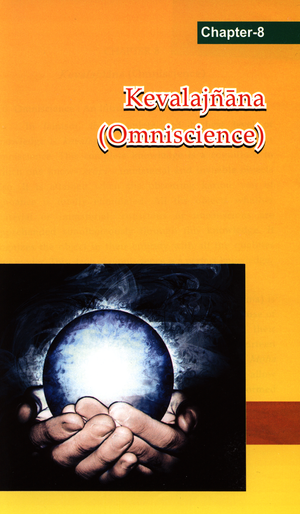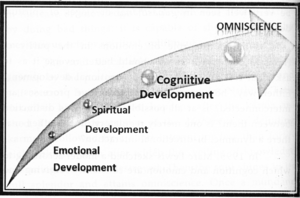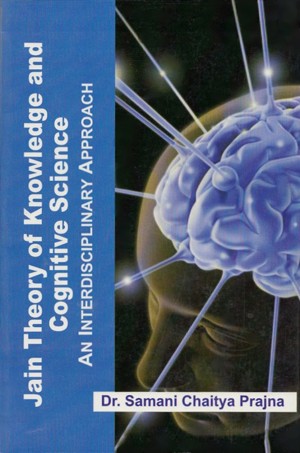
8.0 Omniscience: An Introduction
In Jainism, the complete and highest level of knowledge is kevalajñāna, which in general is known as omniscience. This complete knowledge is a cognition, in which one knows arūpī - immaterial and invisible objects also. It is attained when the obscuring karmic veil of ignorance is totally eliminated. All the objects whether material or immaterial, conscious or unconscious are apprehended simultaneously through this knowledge. It cognizes the object in their entirety with all the qualities and modes. This stage of omniscience is a perfect knowledge.
8.1 Karma and Omniscience
According to Jainism, Mohanīya (deluding karma) is most powerful of all the karmas. This is the major cause of bondage of the soul. The other karmas also get their strength from moha. The arrangement of fourteen guṇasthāna is also based on its different levels. Moha operates on the soul in two ways. Firstly, it does not allow the soul to know its own reality. This action is performed by darśanamohanīya (view deluding) karma. Secondly, it obstructs soul in its attempt to attain the pure state of bliss. This action is performed by cāritra (conduct) mohanīya karma.
All categories of knowledge, other than omniscience, are accompanied by ignorance due to the constant rise of knowledge-covering karma. Karma exists simultaneously in three states:
- Eliminated
- Partially eliminated and partially suppressed and
- Rising state.
The first two states leads to knowledge. Form the third state is rising state of karma leading to ignorance.
All categories of knowledge, other than omniscience are an amalgam of knowledge and ignorance. To have absolutely eliminated all knowledge-covering karma is to be omniscient.
According to Jain epistemology, all extra sensory perception is produced by the self-alone. It is neither assisted by sense-organs nor the mind. It is a natural quality of the soul, which on account of the karmic obscurance is not manifested. It gets its manifestation according to the partial or total removal of the corresponding karmic obscurance. Umāsvāti defines the domain of omniscience as that which extends to all substances in all their modes[1]. In the Illuminator of Jain Tenets, Ganadhipati Tulsi has defined it as that which directly cognizes all the substances with all their modes is omniscience.[2]
Omniscience can also be referred to as the pure and perfect knowledge. Jain texts[3], further explains that it is infinite, eternal, imperishable and beyond grades. It explains that in the state of omniscience, knowledge is infinite because it knows the infinite modes of objects, it is eternal because it functions incessantly, it is imperishable because once omniscience is obtained it never goes away and lastly, it is beyond any gradation because it has only one degree i.e. par excellence unlike the other types of knowledge.
Omniscience is a knowledge that occurs directly from the soul and therefore it does not require the use of senses and mind. In short, it is the totality of all knowledge.
Omniscience, if defined in more simpler words, is an overall knowledge of overall objects of knowledge as said 'He who knows one knows all. He who knows all knows one. From the Ācārānga Bhāṣyaṃ[4] sums this point as the omniscient knows the relative existence and all the modes of every object. Since all objects are inter-related, perfect knowledge of one object makes it possible to know all the objects of the world. This relation of all objects, according to Jainism, is further explained by Nathmal Tatia, symbolically as the relations are links between A and the contents of not-A. This means that complete knowledge of A implies the complete knowledge of not-A and this is obviously the knowledge of the whole universe. In other words, the perfect knowledge of one entity means the perfect knowledge of all entities.[5] Knowing all the modes of every object also indicates knowing them in all the three tenses of time, i.e. past, present and future. This is explained in the Ācārānga Vṛtti[6] that one who is capable of examining any atom or any other substance in its present, past and future mode is capable of knowing all its own and alien modes. This is so because there is universal concomitance between the knowledge of all things and the knowledge of all the past and future modes of a substance.
From the above definitions and descriptions, it is clear that what omniscience is. Now let us know the process to obtain omniscience. Omniscience is though the nature of soul not acquired due to the presence of obscurance of karma. From eternity each soul is obstructed by karma. This obstruction prevents the true nature of the exploration of soul to be prevailed, which is omniscience in the case of knowledge. Just as each soul attracts karma by doing bad things; it is capable of shedding them by meritorious acts or spiritual upliftment.
The soul is capable of removing the obscuring karmas by the practice of meditation, contemplation and self-control[7]. In Studies in Jain Philosophy, Nathmal Tatia describes how omniscience happens after the karma are shed. The total destruction of the Mohanīya or deluding karma is followed by a short interval for less than forty-eight minutes soon after which the veiling of knowledge obscuring karma are destroyed. Then the soul shines in its full splendour and attains omniscience. Once a mundane soul attains omniscience, it will be a liberated soul or siddha upon leaving the physical body.
8.2 Emotional - Spiritual Development and Omniscience
For the normal human being it is unimaginable to think of the knowledge an omniscient has. Though, it should be satisfying to know that every soul is capable of attaining omniscience through spiritual development as it is the true nature of the soul. The Jainas hold a very clear and systematic view about the journey of soul in its spiritual development. According to Jainism, without winning over emotions one cannot succeed in any field in general and in the field of spirituality in particular. There are fourteen stages of spiritual development in Jainism called as guṇasthānas[8] These stages depict a clear picture of interrelationship between emotional, spiritual and cognitive development. The intricate relationship between them can be very well seen in guṇasthāna or stages of spiritual development.
What is the role of emotions in the purity of (human) cognition? Or we should better reverse it as to ask what role cognition plays in emotional development? Either way, how emotional and cognitive processes are interconnected? is at all possible to draw this distinction between them? Is one merely regulatory for the other or is there a dynamic, bi-directional interaction?
In 1995, Marc Lewis[9] sketched a model according to which cognition and emotion are constantly receiving and providing reciprocal feedback. Such a dynamical approach seems promising for it admits both cognition-emotion and emotion-cognition interaction even at the same time, to various degrees and dynamically changing. This relation seems to square relatively well with empirical evidence suggesting a causal link both from cognition to emotion and from emotion to cognition.
Jain theory omniscience clearly depicts a clear interrelation between three major aspects such as cognition, emotion and spirituality as follows i.e. emotional development leading to spiritual development and spiritual development in turn leads to purity in cognition finally producing a state of omniscience, a complete state of being emotionally, spiritually and cognitively.
Fig No. 8.1. Process of Omniscience

In Jain terms emotions are nothing but passions as what emotions are comprised of is the component of passions too. It is a subject of controversy between different schools of thought. But still we can take certain terms as emotion-terms such as fear, anger, craving indignation, remorse, embarrassment, grief, distress, joy, craving, disgust, jealous etc. In general they can be classified under two heads; pleasant and unpleasant. Jain philosophers define passions as in temperance of the nature of attachment and hatred.
These passions are mainly classified into four categories as follows:
- Anger
- Pride
- Deciet
- Greed.[10]
Each of the above are further divided in to four sub-varieties or degrees according to the strength of the emotions:
- Anantānubandhī (cause of endless transmigration)-the most intense kind of passion
- Apratyākhyāna (cause of non-renunciation) - a stronger kind of passion
- Pratyākhyāna (cause of partial renunciation) -milder emotion
- Sañjvalana (flaming up)- subtle passion.
Anantānubandhī (cause of endless transmigration) are the most intense kind of passions which can be termed as 'heightened' emotionality in Psychology. 'Heightened' emotionality is characterised by inability to control the emotions leading to social and emotional mal-adjustments.[11]
The first variety of anger is comparable to scratch on stone, one which persists for an infinitely long time; is intense passion. The second variety of anger is comparable to scratch on earth which is less persistent than the first. The third is like a scratch on sand, which endures for a short time; the fourth is like a scratch on water which is immediately obliterated.
. Similarly, the strongest variety of pride is compared to hard stone which does not bend. The second is like a bone pillar which bends in a slight degree. The third is like a pillar of wood-a little more flexible. The fourth is like a creeper which is very flexible.
Deciet also has four varieties comparable to a root of a bamboo tree, horn of ram, the line of urine left by walking bull and the skin of bamboo being peeled respectively. The four kinds of greed are comparable to the colour of silk-worm, of mud safflower and turmeric which differs in degree in respect of intensity and duration.[12]
Apart from the above sixteen kinds of passions, Jainism also describes nine quasi passions, which are as follows: laughter, relish, ennui, grief, fear, abhorrence male sexual disposition, female sexual disposition and hermaphroditic sexual dispositions.[13]
Passions are known to be hurdles in spiritual development. Emotional maturity, emotional control, control over passions and spiritual development are interrelated. More the emotional maturity and control, the better is spiritual development. There can be infinite variation between one and the other emotion. But the development of emotions from the most unpleasant emotion to the least unpleasant or pure emotion and from the least state of emotional control to the highest state of emotional control can be explained through the fourteen stages of spiritual development known as guṇasthāna. These represent minimum to total developmental stages of spirituality has been divided into fourteen stages by Jain philosophy. A brief outline of fourteen guṇasthāna is as follows:
Through the purity of the psyche the sequentially higher stages of spirituality are achieved by the soul, whereas with impurity one moves sequentially to the lower stages.
1. Mithyādṛṣṭi Guṇasthāna (State of Perverted Belief)
This is soul's original and beginning less state of perverted or deluded world view.[14] The one whose faith in realities is false (perverted), is known as a person with perverted belief (Mithyādṛṣṭi) and his stage of spiritual development as a state of perverted belief. One is in such a state on account of strongest category of emotions or passions called Anantānubandhī passions.[15]
2. Sāsvādanasamyakdṛṣṭi Guṇasthāna (Lingering Relish of Right Belief)
The stage of spiritual development of the view of person with lingering taste of right belief is known as state of lingering relish of right belief. When a person moves from right view world to perverted faith, until he does not reach the first stage of perverted faith, the intermediate position is known as state of lingering relish of right belief.
3. Miṣradṛṣṭi Guṇasthāna (Mixed State of Spiritual Development)
This is the oscillating state of soul with doubt. The view towards reality is mixed, whether it is right or wrong; this way it is doubtful. Person having this oscillating state belongs to the mixed state of spiritual development. The only difference between first and third stage of spiritual development is that in the former, the view of person is totally perverted, whereas in the later state the view is in a doubtful state.
4. Aviratisamyak Dṛṣṭi Guṇasthāna (Right belief Attended with Non-abstinence)
The one who has acquired right belief (view), but do not. have any kind of abstinence. This stage of spiritual development is called as right belief attended with non-abstinence. This is a state of right world view without abstinence. The faith towards truth is established but in not in position to follow the right conduct. In this condition, one acquires self-realisation. The person acquires discretion that the body is different from self. What is the goal of my life? Why am I here? What are the ways of coming out of this bondage? The self-ponders over all the above thoughts. It tries to move towards liberation. In other philosophies it is also called as self-realization and enlightenment too.
5. Deśavirati Guṇasthāna (Right belief with Partial Abstinence)
Those who are both abstinent and non-abstinent but are not completely restraint, their state of spiritual development is known as right belief with partial abstinence. Here starts the conduct of truth.
6. Pramattasamyata Guṇasthāna (Self-restraint Unexampled from Remissness)
The stage of spiritual development of a non-vigilant saint is known as state of abstinence with remissness. In this stage, there is strong (resolution) determination to follow the conduct of truth life turns to be full of aspirations and abstinence.
7. Apramattasamyata Guṇasthāna (Self-restraint with Free from Remissness)
The state of spiritual development of a vigilant monk (saint) is known as state of self restraint with freedom from remissness. In this state, remissness is totally absent. Therefore this state is more pure than the sixth state.
8. Nivrittibādara Guṇasthāna (Dissimilar Coarse Passions)
The state in which soul is freed from coarse passions, (partially, either suppressed or destroyed) is called as dissimilar coarse passion state. In this state, the soul is devoid of coarse passions (anger, proud, deceit and greed).
9. Anivrittibādara Guṇasthāna (Similar Coarse Passions)
In this state, the aspirant has not dispensed with slight residue of coarse passions. This state constitutes on appreciable advance in respect of eradication of coarse passions over the antecedent states. In eighth stage, there is erudition of passion to some extent. Therefore, it is known as nivṛtti (eradication) whereas ninth state refers to small remains of passions left. The name of the eighth stage is based on passions that are eradicated, whereas the name of ninth stage is based on passions that are still to be eradicated.
10. Sūkṣma samparāya (Subtle Passion State)
The word 'samparāya' means greed or passions. The tenth state of spiritual development where subtle passions remains is known as Sūkṣma samparāya or state of subtle passions. In this state anger, pride and greed. These three passions are subsided or destroyed, only a small amount of greed remains.
11. Upashanta Moha (Subsidence of Delusion)
When the passions or delusion as absolutely repressed for an infra 48 minutes (within 48 minutes). This state is known as repressed passion state or subsidence of delusion. In this state, the greed that remained through ' previous stages is absolutely suppressed, but is not destroyed or uprooted. It is just like covering fire through ash which soon flames up again.
12. Kśīṇa Moha (Extirpation of Passion)
Whose passions is absolutely extirpated, his state of development is known as extirpated state of spiritual development. In the previous stage where flaming up (subtle) greed is not destroyed, is here absolutely destroyed. The soul becomes absolutely dispassionate. lit attains a state called vītarāga.
13. Sayogī kevalī (Omniscience with Activities)
An omniscient with activities of mind, speech and body, the state of his/her spiritual development is known as omniscience with activities. In this condition, four destructive karmas knowledge covering karma, intuition covering karma and obstructive karma are absolutely destroyed. The soul attains omniscience and Omni-intuition and non-obstruction. This stage proceeds the 12th stage in which total destruction of all passions occurs. This shows for omniscience to be attained first one has to remove all kinds of passions and emotive impulses. The purity of emotions leads to cognitive purity in thirteenth stage.
14. Sayogī kevalī (Omniscience with Total Cessation of Activities)
An omniscient in this stage is one who is bereft of activity. The stage of his spiritual development is known as omniscience without activities. In this state, the omniscient stops all his mental, verbal and physical activities and becomes action less. It destroys all karmas which were attached to soul from time immemorial and attains liberation. This leads to the end of transmigration or cycle of birth and death.
Sequence of Cognitive Development in Relation to Stages of Spiritual Development
In the first stage, there remains perverted intellect. There is strong belief in materialism as sensical; and spirituality as non-sense. This is just an opposite mental condition. In such a situation, whatever destruction cum subsidence of knowledge determining karma occurs, that would be taken as a spiritual development but the perversity which makes it to have wrong faith is not really a spiritual development.
He cognizes cow as a cow and ox as an ox and all other things as they are. His right knowledge is a part of his spiritual development. He does not have interest in exploration of truth, thus called as perverted world viewed. All the activities of him cannot be considered as wrong or perverted conduct. He can also perform auspicious activities in accordance with emancipation. In this condition, the minimum (least) development takes place but is not considered as a stage of developmental sequence.
The second stage is not a stage of spiritual progress; rather it is a regression of spiritual progress. It is an intermediate duration between progress and ultimate regression.
The third state of movement of soul to progress and regress. The movement towards regression from fourth stage' of development and progress is from first state to the third.
Once the duration of karmic bondages fructifies and having the congenial environment the internal effort begins, leading to the cleavage of delusion and the person attains enlightened world view. This is fourth stage of spiritual development. After the attainment of enlightened world view, the partial abstinence occurs for a limited period of time. This is fifth stage of spiritual development. When it enters into full abstinence, the sixth stage is acquired. It is a state of only abstinence where all material intensions are left out. This leads experience of gradually increasing happiness. In the sixth and seventh state the aspirant partly eliminates and partly suppresses the milder passion.
In eighth state, there is need of strongest will power to destroy delusion. In this state, there is novel spiritual purity. Therefore it is also called as unprecedented state, (apūravakaraṇa). From this, there emerge two ladders; ladder of subsidence and the ladder of destruction.
During eighth, ninth and tenth stages, the soul is in on one of the ladders: the ladder of suppression of emotions or the ladder of elimination of emotions. In the ladder of suppression, the following sub types of emotions are gradually suppressed.
- Hermophrodic disposition.
- Female disposition and the six quasi passion (3-8) laughter, relish, ennui, grief, fear and abhorrence. [16]
- Male disposition and the four passion of non-abstinence and the four passions of partial abstinence and subtle anger and pride. There after the subtle deceit is suppressed and subtle greed is attenuated but not yet suppressed completely at the first unit of tenth stage of spiritual development called complete self-restraint with subtle greed.
- In the first time unit of eleventh stage, there is complete self-restraint with suppressed passions occur, where all passions are radically suppressed.
In ninth stage, anger, pride and deceit and in the tenth stage, greed is destroyed or subsided. The soul in subsided ladder moves for the eleventh state and the soul with destructed state of passions moves to the twelfth stage' of spiritual development. For the eleventh state, the soul moves forward with subsequent subsidence, therefore after an infra hour or an antarmuhurta its movement downwards in lower stages is unavoidable. The soul that moves to twelfth stage directly from the tenth, destructing delusion moves forward and attains omniscience in the thirteenth stage. A soul first inhibits its mental activities and then verbal and the bodily activities are inhibited. Eventually, the soul attains fourteenth stage of spiritual development. This has a very short term and this leads to the emancipation of the soul.
Thus, these fourteen stages of spiritual development is a journey of suppression or elimination of passion and delusion. It is the movement of soul from strongest passion to no passion state from deluded to non-deluded cognition i.e. from impure to purest cognition called omniscience as Tattvārtha Sutra[17] defines omniscience as:
Mohakṣayāj jñāna- darshanāvaraṇāntarāyakṣayāc ca kevalaṁ
Omniscience arises when deluding karmas are eliminated and as a result, knowledge and intuition covering karma are eliminated.
After a brief exposition of different kinds of cognition, we can conclude that cognition is the inherent nature of the soul. Each kind of cognition has its own importance but manifested in different degrees depending upon the subsidence and destruction of karmic veils. When these veils are totally removed, infinite cognition of soul manifests itself in the form of pure and perfect cognition. All imperfectness, incompleteness of cognition dissolves with the rise of omniscience.
Samavāo, A.14.5, Kammamvisohi maggaṇaṁ paḍucca cavadasa jīvaṭṭhāṇā paṇṇatā, tam jahā-- micchādiṭṭī sāsāyaṇasammadiṭṭhī...
Lewis, M. D. Cognition-emotion feedback and the self-organization, of developmental paths. Human Development, vol. 38 (2), 1995, pp. 1-102
 Samani Chaitya Pragya
Samani Chaitya Pragya

